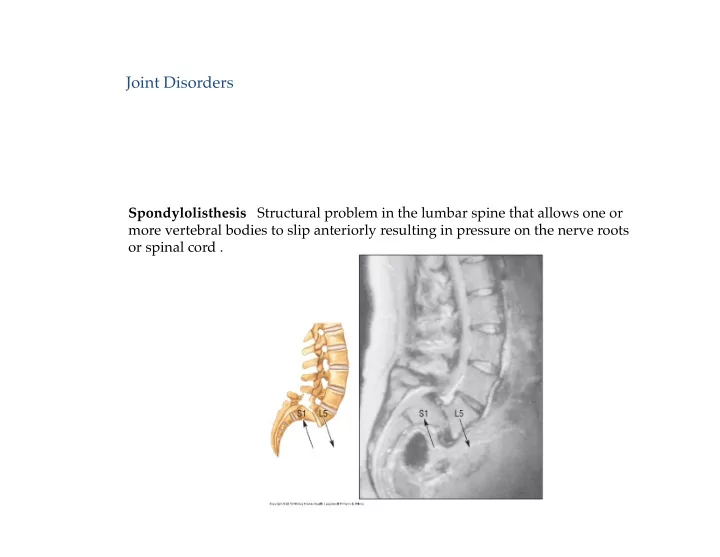

Joint Disorders � Spondylolisthesis Structural problem in the lumbar spine that allows one or more vertebral bodies to slip anteriorly resulting in pressure on the nerve roots or spinal cord . �
Joint Disorders � Spondylosis Degenerative arthritis involving age-related changes of the vertebrae, discs, joints, and ligaments of the spine . �
Joint Disorders � Sprains Torn or permanently stretched ligaments. �
Joint Disorders � Temporomandibular joint dysfunction (AKA: TMJ dysfunction) Umbrella term that can refer to a multitude of common problems in and around the jaw. Signs and symptoms include dysfunctional bite (malocclusion), teeth grinding (bruxism), and loose ligaments surrounding the jaw. �
Fascial Disorders � � Compartment syndrome � � Dupuytren contracture � � Ganglion cyst � � Hammertoe � � Hernia � � Plantar fasciitis � � Pes planus � � Pes cavus �
Fascial Disorders � Compartment syndrome Injury or repetitive stress creates pressure inside a tight fascial compartment that can lead to the starvation and death of muscle and nerve cells. �
Fascial Disorders � Dupuytren contracture (AKA: palmar fasciitis) Idiopathic thickening and shrinking of the palmar fascia that limits movement of the fingers. �
Fascial Disorders � Ganglion cyst Small connective tissue pouches filled with fluid that grow on joint capsules or tendinous sheaths. �
Fascial Disorders � Hammertoe Foot deformity that affects the lateral toes by permanently shortening the muscles and tendons. Results in hyperextension at the metacarpal-phalangeal and distal interphalangeal joints, but flexion at the proximal interphalangeal joint. �
Fascial Disorders � Hernia Hole or rip in fascia through which structures such as muscles or vertebral discs may protrude. �
Fascial Disorders � Hernia Hole or rip in fascia through which structures such as muscles or vertebral discs may protrude. � � Inguinal hernia Hole in the abdominal wall at the inguinal ring � caused by a sudden change in abdominal pressure such as coughing, � sneezing, or heavy lifting especially with simultaneous twisting. �
Fascial Disorders � Hernia Hole or rip in fascia through which structures such as muscles or vertebral discs may protrude. � � Hiatal hernia Enlargement of the diaphragmatic hiatus allowing � the esophagus to pass from the thorax to the abdomen or the � stomach to protrude into the thorax. Major contributor to � � gastroesophageal reflux disorder (GERD). �
Fascial Disorders � Plantar fasciitis (AKA: PF) Pain in the plantar fascia caused by repeated microscopic injury and collagen degeneration. �
Fascial Disorders � Pes planus (AKA: flat feet) Feet that lack the medial, lateral, and transverse arches of the plantar surface of the foot. �
Fascial Disorders � Pes cavus (AKA: high arches) Feet with hyperaccentuated arches that do not flatten out with each step, but instead stay high and immobile. �
Neuromuscular Disorders � � Carpal tunnel syndrome � � Disc disease � � Herniated disc � � Myofascial pain syndrome �
Neuromuscular Disorders � Carpal tunnel syndrome (AKA: CTS) Set of signs and symptoms brought about by the entrapment of the median nerve between the carpal bones of the wrist and the transverse carpal ligament that holds down the flexor tendons. �
Neuromuscular Disorders � Disc disease Collection of problems in which the nucleus pulposus and or the annulus fibrosus of an intervertebral disc extends beyond its normal borders. �
Neuromuscular Disorders � Herniated disc The nucleus pulposus of a vertebral disc extends beyond the vertebral body. � � Bulge Entire disc protrudes symmetrically. � � Protrusion Nucleus pulposus extends out in one direction. � � Extrusion Narrow piece of the nucleus pulposus protrudes. � � Rupture Nucleus pulposus bursts and leaks its entire contents. �
Neuromuscular Disorders � Myofascial pain syndrome (AKA: MPS) Condition involving the development of many myofascial trigger points. �
Neuromuscular Disorders � Thoracic outlet syndrome (AKA: TOS) Nerves of the brachial plexus or blood vessels running to or from the arm are impinged or impaired at one or more of three places: anterior/medial scalenes, clavicle/ribs, pectoralis minor/ribs. �
Other Connective Tissue Disorders � � Bunions � � Bursitis � � Shin splints � � Tendinitis � � Tendinosis � � Tenosynovitis � � De Quervain tenosynovitis � � Whiplash �
Other Connective Tissue Disorders � Bunions (AKA: hallux valgus) Bursa protrusion at the metatarsophalangeal joints of the great toe that occurs when the great toe is laterally deviated. �
Other Connective Tissue Disorders � Bursitis Inflammation of a bursa due to irritation and generation of excess fluid. �
Other Connective Tissue Disorders � Tendinitis Acute tendon injury leading to inflammation. �
Other Connective Tissue Disorders � Tendinosis Long-term degeneration of collagen fibers in tendons. �
Other Connective Tissue Disorders � Tenosynovitis Irritation developing where tendons slide through their synovial sheaths. �
Other Connective Tissue Disorders � De Quervain tenosynovitis Tenosynovitis of the abductor and extensor pollicis tendons. �
Other Connective Tissue Disorders � Whiplash (AKA: cervical acceleration-deceleration, CAD) Mixture of injuries including sprains, strains, and joint trauma associated with the head whipping backwards and then forward in rapid succession. �
27a Pathology: Musculoskeletal System ¡
Recommend
More recommend